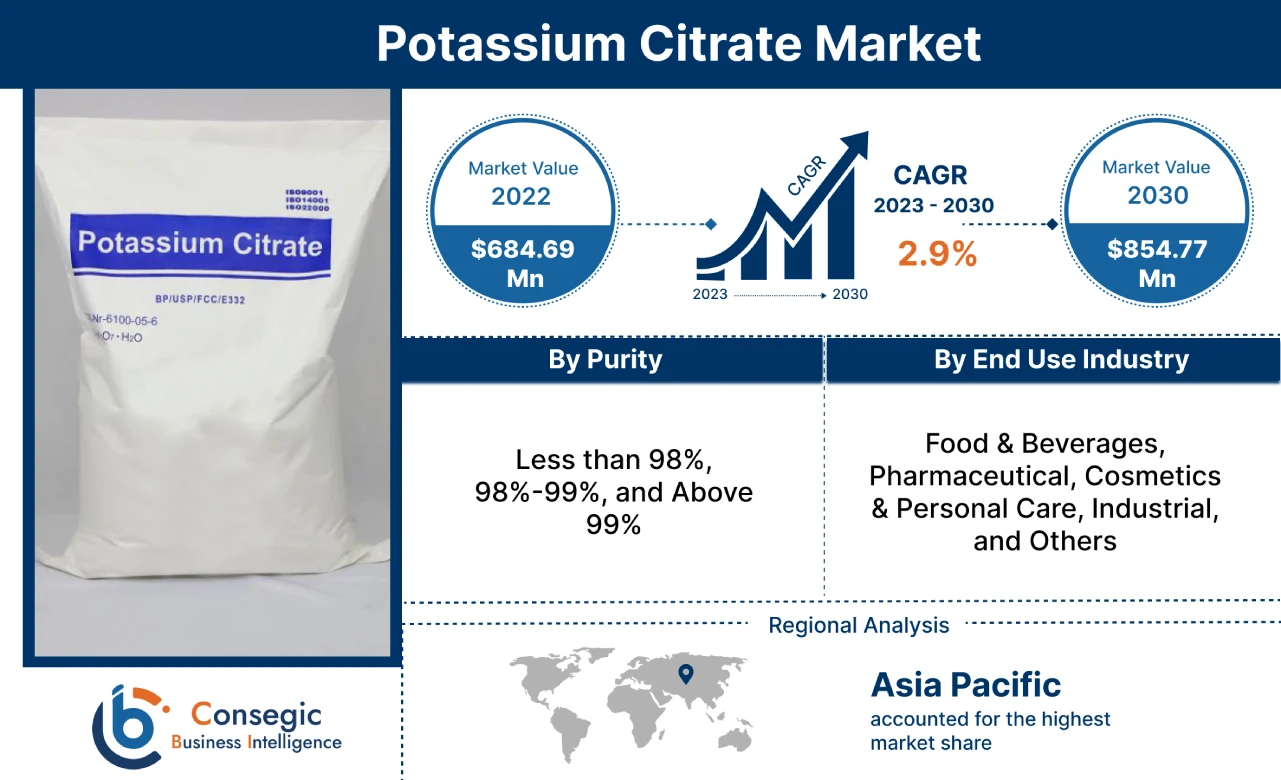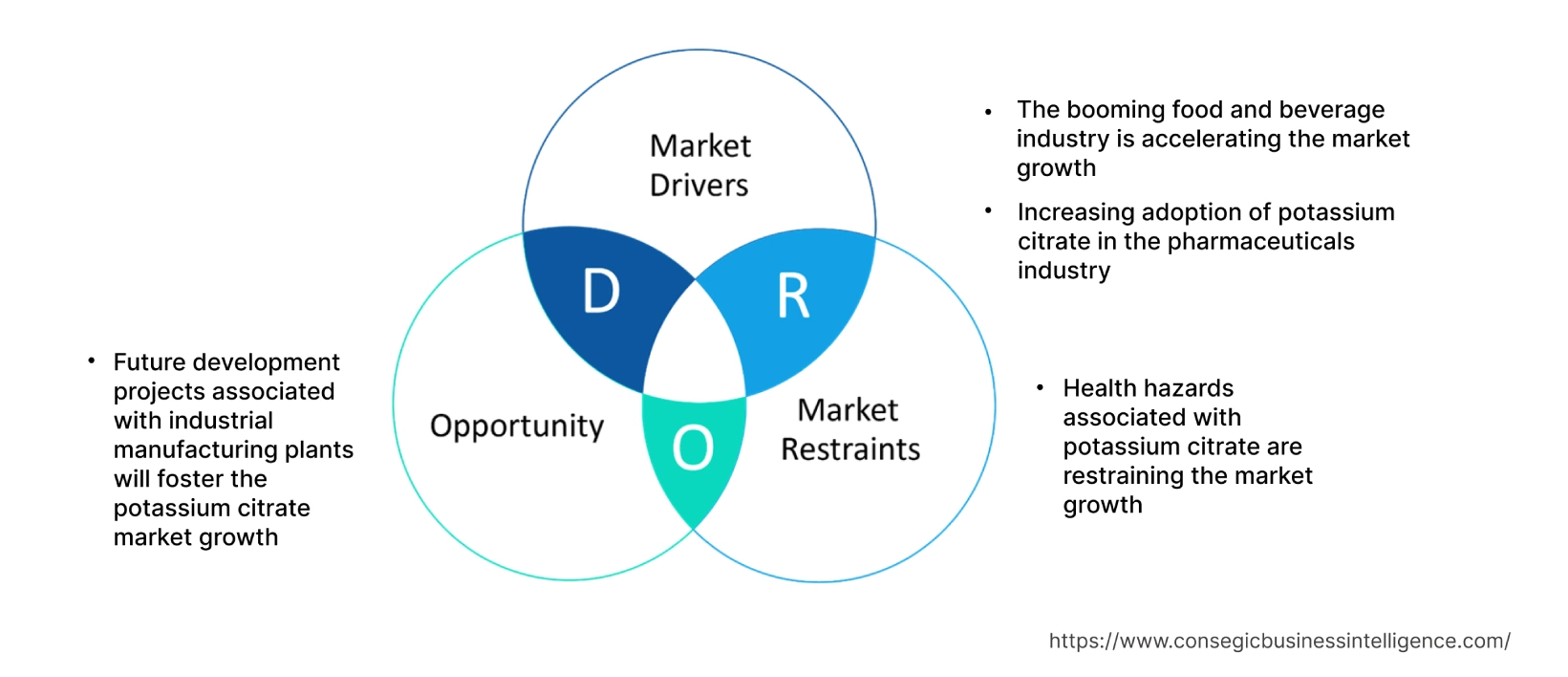Potassium Citrate Market Size :
Consegic Business Intelligence analyzes that the potassium citrate market size is growing with a healthy CAGR of 2.9% during the forecast period (2023-2030), and the market is projected to be valued at USD 854.77 Million by 2030 from USD 684.69 Million in 2022.
Potassium Citrate Market Definition Scope & Overview:
Potassium citrate is a type of potassium salt of citric acid and is available in white, hygroscopic crystalline powder form. The vital benefits associated with potassium citrate include supporting healthy kidney function, increasing bone mineral density, and improving cardiovascular health, among others. In addition, potassium citrate provides an aid to preserve cosmetics and personal care products by chelating (complexing) metals. Potassium citrate is available in various purities, including less than 98%, 98%-99%, and above 99%. As a result of the above benefits, potassium citrate is frequently utilized in various end-use industries, such as food & beverages, pharmaceutical, cosmetics & personal care, and industrial, among others.
Potassium Citrate Market Insights :
Potassium Citrate Market Dynamics - (DRO) :
Key Drivers :
The booming food and beverage industry is accelerating the market growth
Potassium citrate is utilized as a flavoring agent in the food and beverage industry to control pH. The potassium citrate substance is deployed in various food and beverage products such as bakery products, dairy products, processed food, non-alcoholic beverages, and others. For instance, according to the International Trade Administration (ITA), the Canadian food and beverage processing industry is ranked as the 2nd largest industry in Canada, accounting for a 20% share in the manufacturing industry. In 2021, the food and beverage processing industry in Canada contributed USD 100 billion, a year-on-year increase of 14.8%. Thus, the booming food and beverage industry is accelerating the demand for potassium citrate to minimize the acidity of foods and beverages. This prominent factor is propelling the market growth at the global level.
Increasing adoption of potassium citrate in the pharmaceuticals industry
potassium citrate is an ideal ingredient for the pharmaceutical industry to eliminate protons, or positively charged atoms, which minimizes acidity in the urine. The pharmaceutical industry's growth at the global level can be ascribed to a variety of factors, including new facility developments, increased output, and government initiatives that are promoting pharmaceutical production growth. For instance, according to the European Federation of Pharmaceutical Industries and Associations, the Europe pharmaceutical industry was valued at USD 339.7 billion in 2021, representing an increase of 4.6% in comparison to USD 324.7 billion in 2020. Hence, the growth of the pharmaceutical sector is driving the demand for potassium citrate to treat kidney stones, hypocitraturic calcium oxalate nephrolithiasis, and other conditions, which is boosting the growth of the market.
Key Restraints :
Health hazards associated with potassium citrate are restraining the market growth
The various health hazards associated with potassium citrate are restraining the adoption of materials in end-use industries such as pharmaceuticals, food & beverages, and others. For instance, potassium citrate has various types of health hazards such as confusion, black stools, irregular heart rate, dizziness, blood pressure, chest pain, painful swallowing, stomach pain, and unusual weakness, among others. In addition, frequent concentrations of potassium citrate led to high potassium levels in the blood. This causes tingling of the hands/feet, rapid weight gain problems, and others. Therefore, the above health hazards associated with potassium citrate are posing a major bottleneck for the market growth during the forecast period.
Future Opportunities :
Future development projects associated with industrial manufacturing plants will foster the potassium citrate market growth
Future anticipated development projects associated with industrial manufacturing plants are likely to be increased due to prominent determinants such as rising government initiatives promoting products made in the country, increasing investment in production expansion, and others. For exemplifier, in April 2022, Ineos, a leading player in the chemical manufacturing industry announces its plans for the development of an acetonitrile manufacturing plant in Germany. Thus, the advent of upcoming future projects for industrial manufacturing will bolster the demand for potassium citrate as it is deployed in preservatives, PH buffers, and cleaning chemicals, among others. This prominent factor will foster market growth during the forecast period.
Potassium Citrate Market Report Insights :
| Report Attributes | Report Details |
| Study Timeline | 2017-2030 |
| Market Size in 2030 | USD 854.77 Million |
| CAGR (2023-2030) | 2.9% |
| By Purity | Less than 98%, 98%-99%, and Above 99% |
| By End-use Industry | Food & Beverages, Pharmaceutical, Cosmetics & Personal Care, Industrial, and Others |
| By Region | North America, Europe, Asia-Pacific, Latin America, and Middle East & Africa |
| Key Players | Cargill, Incorporated., ADM, Tate & Lyle, Juxian Hongde Citric Acid Co.LTD, Niran BioChemical Limited, Gadot Biochemical Industries, Huangshi Xinghua Biochemical, FBC Industries, Adani Pharmachem, and Global Calcium |
Potassium Citrate Market Segmental Analysis :
By Purity :
The purity segment is categorized into less than 98%, 98%-99 %, and above 99%. In 2022, the above 99% segment accounted for the highest market share of 52.75% in the overall potassium citrate market. The above 99% purity of potassium citrate is widely employed in the production of pharmaceuticals, food & beverage, and other products. The increasing demand for the above products across various industries has led to the growth in the utilization of the above 99% purity potassium citrate. Moreover, above 99% potassium citrate ensures superior properties such as neutral and organic which are beneficial for the production of pharmaceutical drugs. For instance, the International Trade Administration projects that the Vietnamese pharmaceuticals market will expand by 10% annually between 2017 and 2028, with revenues per capita nearly tripling between 2017 and 2027. Thus, due to the above-mentioned factors the adoption of above 99% purity of potassium citrate is increasing. As a result, the segmental growth of above 99% is leading to the potassium citrate market growth.
However, the 98%-99% segment is projected to be the fastest-growing segment during the forecast period. This is due to the increasing adoption of 98%-99% in the cosmetics and personal care industry, which is fostering segmental growth.
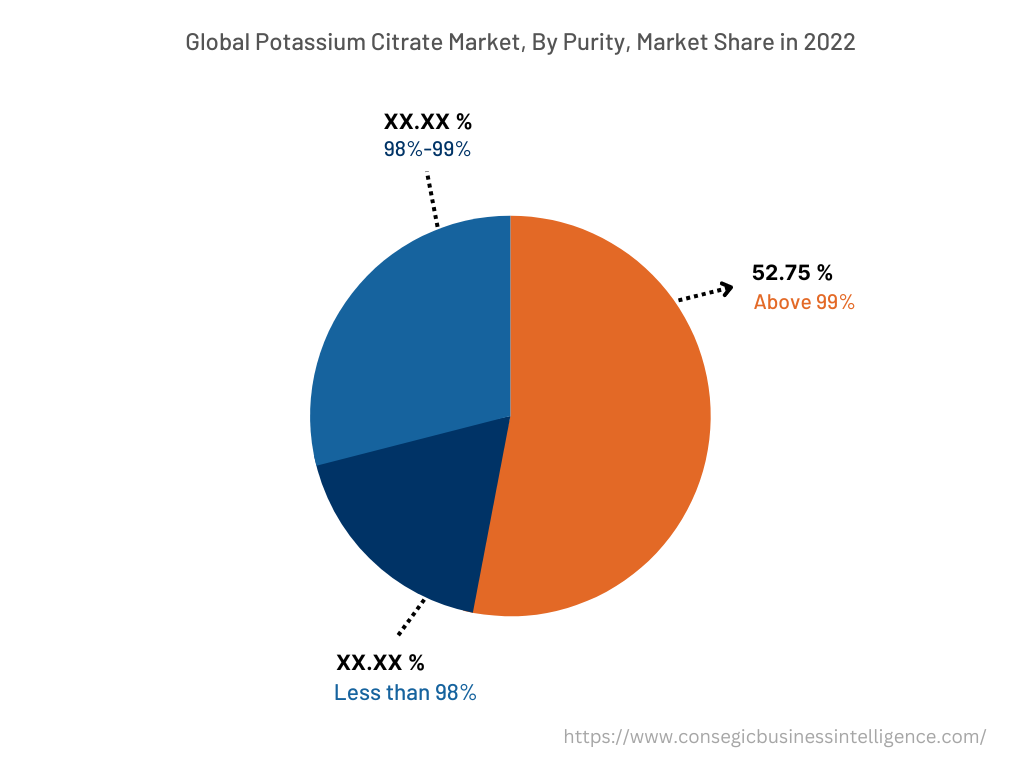
By End-Use-Industry :
The end-use industry segment is categorized into food & beverages, pharmaceutical, cosmetics & personal care, industrial, and others. In 2022, the food & beverages segment accounted for the highest market share in the potassium citrate market. Potassium citrate is employed in the food and beverage industry to improve the taste and texture of food and beverage products. Potassium citrate is deployed as a food preservative to have a buffer so that the pH levels is controlled in an alkaline state. This inhibits the function of certain enzymes. The above feature ensures preserve food for longer. Thus, potassium citrate is ideal for food and beverage products such as bakery products, chocolates & confectionery, dairy products, and others. For instance, according to Food Drink Europe, a European Union confederation for the food and beverage industry, in 2021, the European Union food and beverage industry turnover was valued at Euro 1,093 billion (USD 1,292.0 billion), and in 2022 it was valued at Euro 1,121 billion (USD 1,177.8 billion), a year-on-year increase of 2.6%. Hence, the bolstering food and beverage industry is proliferating the demand for potassium citrate to provide a balanced flavor. This, in turn, is driving the market growth.
However, the pharmaceutical segment is expected to be the fastest-growing segment during the forecast period. This growth is attributed to factors such as increasing investment in new pharmaceutical plants, government initiatives for pharmaceuticals, and others.
By Region :
The regional segment includes North America, Europe, Asia Pacific, Middle East and Africa, and Latin America.
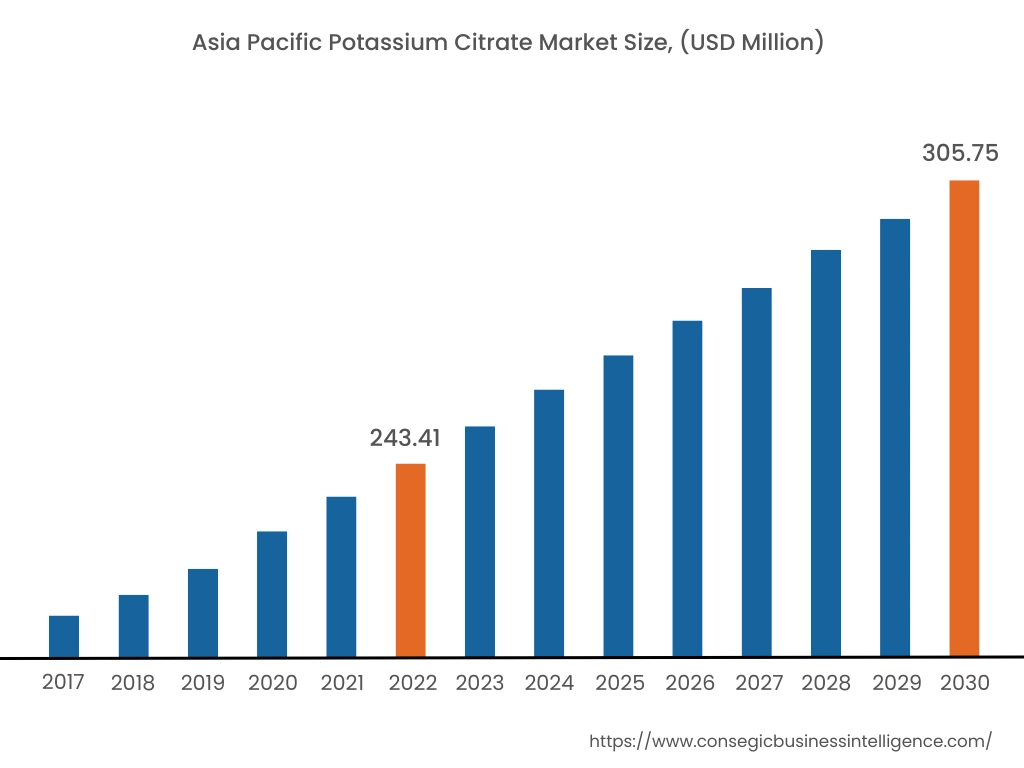
In 2022, Asia Pacific accounted for the highest market share at 35.55% and was valued at USD 243.41 million, and is expected to reach USD 305.75 million in 2030. In Asia Pacific, China accounted for the highest market share of 26.05% during the base year of 2022. The expansion of various end-use industries such as industrial, pharmaceuticals, food & beverage, and other industries are boosting the growth of the potassium citrate market in the Asia Pacific region. For illustration, according to the State Council, The People's Public of China, the agricultural and sideline food processing industry in China registered an annual growth rate of 5.7% in 2021. Therefore, the advancements in the above end-use industries are favoring the demand for potassium citrate, thereby supplementing the market growth.
Furthermore, Europe is expected to witness significant growth over the forecast period, growing at a CAGR of 3.3% during 2023-20230. This is due to the exponential growth in the adoption of potassium citrate in end-use industries such as food & beverages, pharmaceutical, cosmetics & personal care, and industrial, among others.
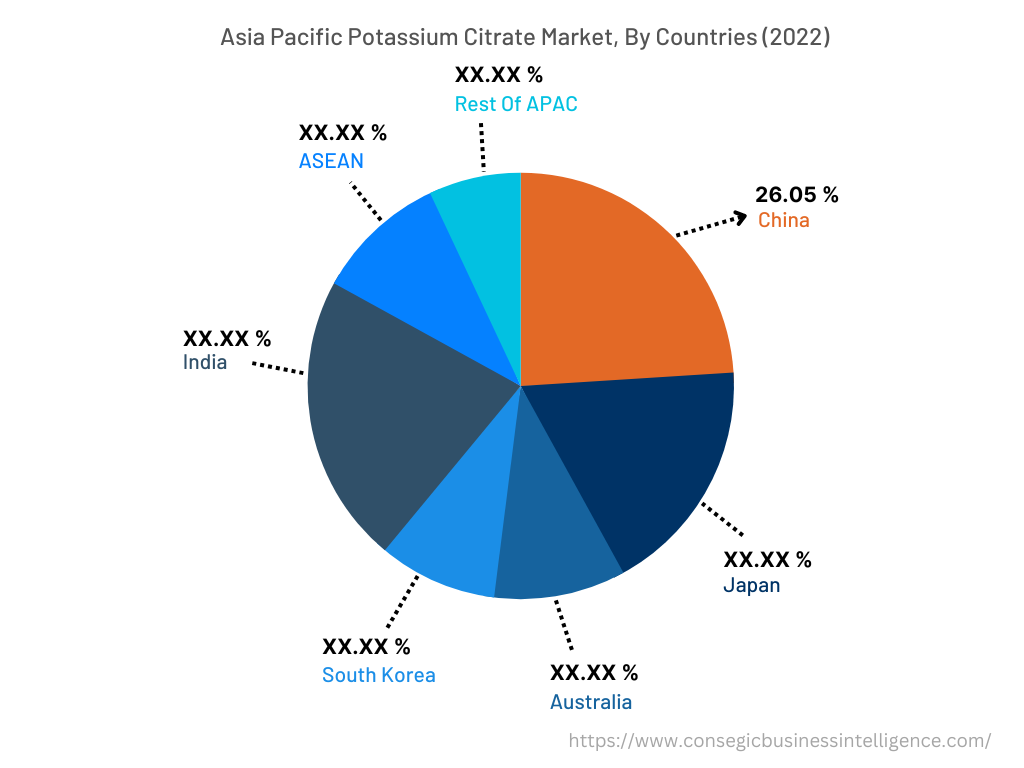
Top Key Players & Market Share Insights:
The potassium citrate market is highly competitive, with several large players and numerous small and medium-sized enterprises. These companies have strong research and development capabilities and a strong presence in the market through their extensive product portfolios and distribution networks. The market is characterized by intense competition, with companies focusing on expanding their product offerings and increasing their market share through mergers, acquisitions, and partnerships. The key players in the market include-
- Cargill, Incorporated.
- ADM
- FBC Industries
- Adani Pharmachem
- Global Calcium
- Tate & Lyle
- Juxian Hongde Citric Acid Co.LTD
- Niran BioChemical Limited
- Gadot Biochemical Industries
- Huangshi Xinghua Biochemical
Recent Industry Developments :
- In April 2021, Camber Pharmaceuticals Inc, a United States-based manufacturer launched Generic Urocit-K, potassium citrate ER tablets. Thus, the development of new products will foster market growth in the upcoming years.
Key Questions Answered in the Report
What was the market size of the potassium citrate industry in 2022? +
In 2022, the market size of potassium citrate was USD 684.69 million
What will be the potential market valuation for the potassium citrate industry by 2030? +
In 2030, the market size of potassium citrate will be expected to reach USD 854.77 million.
What are the key factors driving the growth of the potassium citrate market? +
The booming food and beverage industry is accelerating the potassium citrate market growth.
What is the dominating segment in the potassium citrate market by purity? +
In 2022, the above 99% segment accounted for the highest market share of 52.75% in the overall potassium citrate market.
Based on current market trends and future predictions, which geographical region is the dominating region in the potassium citrate market? +
Asia Pacific accounted for the highest market share in the overall potassium citrate market.
